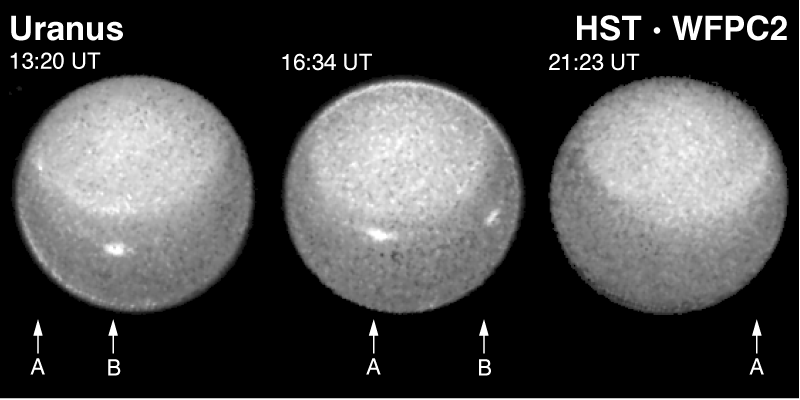Hubble Tracks Rotation of Uranus
![]()
| Home Michael Ammar Solar System Solar System Summary Sun Sun's Statistics Mercury Mercury's Statistics Venus Venus' Statistics Earth Earth's Statistics Mars Mars' Statistics Asteroid Field Asteroid Field's Statistics Jupiter Jupiter's Statistics Saturn Saturn's Statistics Uranus Uranus' Statistics Neptun Neptun's Statistics Pluto Pluto's Statistics Picture Library |
 |
| Hubble Tracks Rotation of
Uranus This view of Uranus was acquired by NASA's Hubble Space Telescope and reveals a pair of bright clouds in the planet's southern hemisphere, and a high altitude haze that forms a "cap" above the planet's south pole. This is just one view of a sequence of three that can be obtained by selecting the above gif image. Hubble's new view was obtained on August 14, 1994, when Uranus was 2.8 billion kilometers (1.7 billion miles) from Earth. These atmospheric details were only previously seen by the Voyager 2 spacecraft, which flew by Uranus in 1986. Since then, detailed observations of Uranus's atmospheric features have not been possible because the planet is at the resolution limit of ground-based telescopes. Hubble's Wide Field Planetary Camera 2 observed Uranus through a filter that is sensitive to light reflected by a pair of high altitude clouds. This makes a high altitude haze over Uranus' south polar region clearly visible, along with a pair of high altitude clouds or plume-type features that are 4,300 and 3,100 kilometers (2,500 and 1,800 miles) across, respectively. (Credit Kenneth Seidelmann, U.S. Naval Observatory, and NASA) |
Send mail to [email protected] with questions or comments
about this web site.
Copyright � 1998 Michael Ammar.